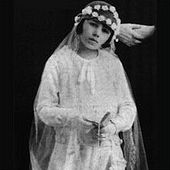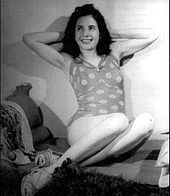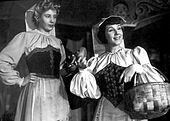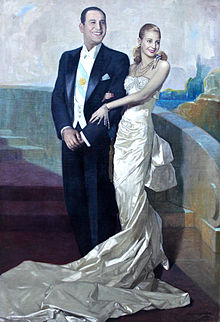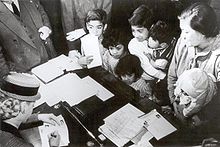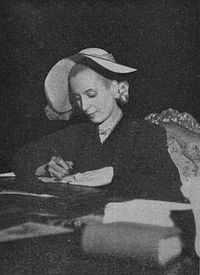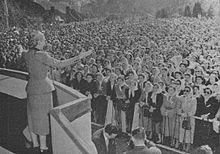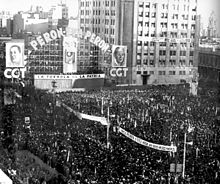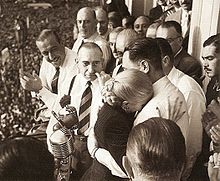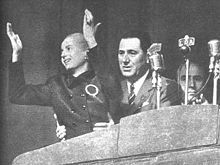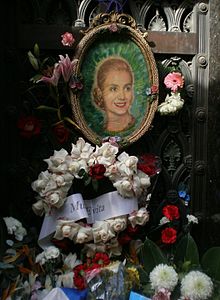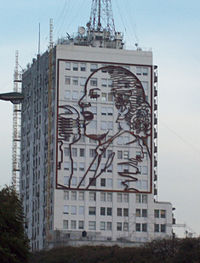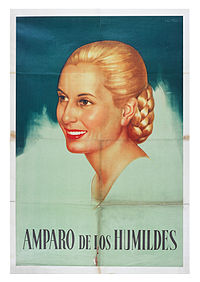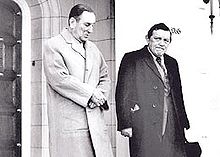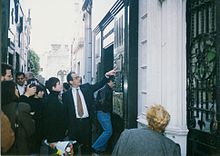
Eva Perón
About this schools Wikipedia selection
SOS Children produced this website for schools as well as this video website about Africa. Sponsoring children helps children in the developing world to learn too.
| Eva Perón | |
|---|---|
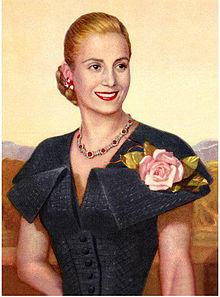 |
|
| Evita's official portrait, 1948 | |
| Spiritual Leader of the Nation of Argentina | |
| In office since 7 May 1952 |
|
| First Lady of Argentina | |
| In office 4 June 1946 – 26 July 1952 |
|
| President | Juan Perón |
| Preceded by | Conrada Victoria Torni de Farrell |
| Succeeded by | Mercedes Villada Achával de Lonardi |
| President of the Eva Perón Foundation | |
| In office 1948 - 1952 |
|
| Succeeded by | Juan Perón |
| Minister of Labour and Social Welfare | |
| Preceded by | Juan Perón |
| President of the Female Peronist Party | |
| In office 1949 - 1952 |
|
| President | Juan Perón |
| Preceded by | position created |
| Succeeded by | Delia Parodi |
| Head of the Argentine Ministry of Health | |
| In office 1946 - 1952 |
|
| President | Juan Perón |
| Personal details | |
| Born | Eva María Ibarguren 7 May 1919 Los Toldos, Argentina |
| Died | 26 July 1952 (aged 33) Buenos Aires, Argentina |
| Nationality | Argentine |
| Political party | Justicialist Party Peronist Feminist Party |
| Spouse(s) | Juan Perón (1945–1952) |
| Occupation | Actress First Lady Politician |
| Religion | Roman Catholicism |
| Signature | |
Maria Eva Duarte de Perón (7 May 1919 – 26 July 1952) was the second wife of President Juan Perón (1895–1974) and served as the First Lady of Argentina from 1946 until her death in 1952. She is usually referred to as Eva Perón (Spanish: [ˈeβa peˈɾon]), or by the affectionate Spanish language diminutive Evita.
She was born in the village of Los Toldos in rural Argentina in 1919, the youngest of five children. In 1934, at the age of 15, she went to the nation's capital of Buenos Aires, where she pursued a career as a stage, radio, and film actress. Eva met Colonel Juan Perón on 22 January 1944, in Buenos Aires during a charity event at the Luna Park Stadium to benefit the victims of an earthquake in San Juan, Argentina. The two were married the following year. In 1946, Juan Perón was elected President of Argentina. Over the course of the next six years, Eva Perón became powerful within the pro-Peronist trade unions, primarily for speaking on behalf of labor rights. She also ran the Ministries of Labor and Health, founded and ran the charitable Eva Perón Foundation, championed women's suffrage in Argentina, and founded and ran the nation's first large-scale female political party, the Female Peronist Party.
In 1951, Eva Perón announced her candidacy for the Peronist nomination for the office of Vice President of Argentina, receiving great support from the Peronist political base, low-income and working class Argentines who were referred to as descamisados or "shirtless ones". However, opposition from the nation's military and bourgeoisie, coupled with her declining health, ultimately forced her to withdraw her candidacy. In 1952, shortly before her death from cancer at the age of 33, Eva Perón was given the title of "Spiritual Leader of the Nation" by the Argentine Congress. Eva Perón was given a state funeral upon her death, a prerogative generally reserved for heads of state.
Eva Perón has become a part of international popular culture, most famously as the subject of the musical Evita (1976). Cristina Alvarez Rodriguez, Evita's great niece, claims that Evita has never left the collective consciousness of Argentines. Cristina Fernández de Kirchner, the first female elected President of Argentina, claims that women of her generation owe a debt to Eva for "her example of passion and combativeness".
Early life
Early childhood
Eva's autobiography, La Razón de mi Vida, contains no dates or references to childhood occurrences, and does not list the location of her birth or her name at birth. According to Junín's civil registry, a birth certificate shows that one María Eva Duarte was born on 7 May 1922. Her baptismal certificate, however, lists the date of birth as 7 May 1919 under the name Eva María Ibarguren. It is believed that in 1945 the adult Eva Perón created a forgery of her birth certificate for her marriage.
Eva Perón spent her childhood in Junín, Buenos Aires province. Her parents, Juan Duarte and Juana Ibarguren (sometimes referred to as Doña Juana), were descended from Basque immigrants. Juan Duarte was a wealthy rancher from nearby Chivilcoy, where he already had a wife and family. During this time period in rural Argentina, it was not uncommon to see a wealthy male with multiple families. However, the lack of legitimacy for Juana and her children would still leave them stigmatized and rejected. Cruelly referred to as "bastards," the family was somewhat isolated. When Duarte suddenly passed away, and his mistress and their children made an attempt to attend his funeral, a small scandal erupted at the church gates. Though Juana and the children were permitted to pay respects to Duarte, they were promptly directed outside afterward. Mrs. Juan Duarte did not want her husband's mistress and children at the funeral, and as his legitimate wife, her orders were respected. Eva would never forget the bitter memory of having her mother and siblings thrown out of her father's funeral.
Previously, Eva being only a year old, Duarte had permanently returned to his legal family, leaving Juana Ibarguren and her large brood destitute, in severe penury. Ibarguren and her children were forced to move to the poorest area of Junín. Los Toldos was an exceedingly poor village of Las Pampas. Barefoot children who lived in dirt floored shacks was the norm in Los Toldos. Las Pampas was known for being a very dusty region, and Los Toldos was viewed as a dreary, desolate place of abject poverty. In order to support herself and her children, Ibarguren sewed clothes for neighbors. The family was stigmatized by the abandonment of the father, especially since Argentine law frowned upon illegitimate children. Eva allegedly destroyed her birth certificate in 1945 so as to erase this part of her past.
Junín
Prior to abandoning Juana Ibarguren, Juan Duarte had been her sole means of support. Biographer John Barnes writes that after this abandonment, all Duarte left to the family was a document declaring that the children were his, thus enabling them to use the Duarte surname. Soon after, Juana moved her children to a one-room apartment in Junín, a miserable arrangement for such a large family. In order to pay the rent on their single-roomed home, mother and daughters took up jobs as cooks in the houses of the local estancias.
Eventually, owing to Eva's older brother's financial help, the family moved into a bigger house, which they later transformed into a boarding house. During this time, young Eva often participated school plays and concerts. One of her favorite pastimes was the cinema. Though Eva's mother apparently had a few plans for Eva, wanting to marry her off to one of the local bachelors, Eva herself dreamed of becoming a famous actress. Eva's love of acting was reinforced when, in October 1933, she played a small role in a school play called Arriba Estudiantes (Students Arise), which Barnes describes as "an emotional, patriotic, flag-waving melodrama." After the play, Eva was determined to become a great actress.
Move to Buenos Aires
In her autobiography, she explained that all the people from her own town who had been to the big cities described them as "marvelous places, where nothing was given but wealth."In 1934, at the age of 15, Eva escaped her poverty stricken village when she ran off with, according to popular myth, a young musician to the nation's capital of Buenos Aires. Eva was blossoming from an awkward, sad looking little girl into a long legged beauty. The young couple's relationship would end almost as quickly as it began, but Eva remained in glamorous Buenos Aires. There she embarked on an exciting adventure, pursuing jobs on stage, radio, and eventually became a film actress. Though never regarded as particularly talented on stage, Eva's beauty was certainly appreciated. Eva had flawless skin, and a willowy figure. Eva had a series of relationships, and via some of these men, she did acquire a number of her modeling appointments. This would be the beginning of Eva's detractors describing her as having been a woman who used men to get what she wanted. When Eva decided to bleach her raven black hair, the effect was striking and quite flattering to her creamy complexion. Eva would keep her hair blonde for the duration of her life. For Eva, Buenos Aires represented an escape from the misery that surrounded her in the provinces.
It is often reported that Eva Perón traveled to Buenos Aires by train with tango singer Agustín Magaldi. However, biographers Marysa Navarro and Nicholas Fraser maintain that this is unlikely, as there is no record of the married Magaldi performing in Junín in 1934 (and, even if he had, he usually traveled with his wife). Eva's sisters maintain that Eva traveled to Buenos Aires with their mother. The sisters also claim that Doña Juana accompanied her daughter to an audition at a radio station, and arranged for Eva to live with the Bustamontes family, who were friends of the Duarte family. While the method of Eva's escape from her bleak provincial surroundings is debated, she did begin a new life in Buenos Aires.
Buenos Aires in the 1930s was the continent's most cosmopolitan and elegant metropolis, and soon became known as the 'Paris of South America.' As in any great European capital, the centre of the city was filled with cafés, restaurants, theaters, movie houses, shops, and bustling crowds. In direct contrast to the glamour of the city, the 1930s were also years of great unemployment, poverty, and hunger in the capital, and many new arrivals from the interior were forced to live in tenements, squalid boardinghouses, and in outlying shantys that became known as villas miserias.
Upon arrival in Buenos Aires, Eva Duarte was faced with the difficulties of surviving without formal education or connections. The city was especially overcrowded during this period because of the migrations caused by the Great Depression. On 28 March 1935, she had her professional debut in the play "The Perezes Misses", at the Comedias Theatre.
In 1936, Eva toured nationally with a theatre company, worked as a model, and was cast in a few B-grade movie melodramas. In 1942, Eva experienced some economic stability when a company called Candilejas (sponsored by a soap manufacturer) hired her for a daily role in one of their radio dramas called Muy bien, which aired on Radio El Mundo (World Radio), the most important radio station in the country at that time. Later that year, she signed a five-year contract with Radio Belgrano, which assured her a role in a popular historical-drama program called Great Women of History, in which she played Elizabeth I of England, Sarah Bernhardt and the last Tsarina of Russia. Eventually, Eva Duarte came to co-own the radio company. By 1943, Eva Duarte was earning five or six thousand pesos a month, making her one of the highest-paid radio actresses in the nation. Pablo Raccioppi, who jointly ran Radio El Mundo with Eva Duarte, is said to have not liked her, but to have noted that she was "thoroughly dependable." Eva also had a short-lived film career, but none of the films in which she appeared were hugely successful. In one of her last films, La Cabalgata del Circo (The Circus Cavalcade), Eva played a young country girl who rivaled an older woman, the movie's star, Libertad Lamarque.
As a result of her success with radio dramas and the films, Eva achieved some financial stability and its comforts. In 1942, she was able to move into her own apartment in the exclusive neighbourhood of Recoleta, on 1567 Calle Posadas Street. The next year Eva began her career in politics, as one of the founders of the Argentine Radio Syndicate (ARA). Again, however, some sources hint at a more scandalous lifestyle.
Early relationship with Juan Perón
On 15 January 1944, an earthquake occurred in the town of San Juan, Argentina, killing some 10,000 people. In response, Perón, who was then the Secretary of Labour, established a fund to raise money to aid the victims. He devised a plan to have an "artistic festival" as a fundraiser, and invited radio and film actors to participate. After a week of fundraising, all participants met at a gala held at Luna Park Stadium in Buenos Aires to benefit earthquake victims. It was at this gala, on 22 January 1944, that Eva Duarte first met the handsome Colonel Juan Perón, who would change her life forever. Eva promptly became the striking colonel's mistress. Eva referred to the day she met her future husband as her "marvelous day". Fraser and Navarro write that Juan Perón and Eva left the gala together at around two in the morning.
Fraser and Navarro claim that Eva Duarte had no knowledge of or interest in politics prior to meeting Perón. Therefore, she never argued with Perón or any of his inner circle, but merely absorbed what she heard. Juan Perón later claimed in his memoir that he purposefully selected Eva as his pupil, and set out to create in her a "second I." Fraser and Navarro, however, suggest that Juan Perón allowed Eva Duarte such intimate exposure and knowledge of his inner circle because of his age: he was 48 and she was 24 when they met each other. He had come to politics late in life, and was therefore free of preconceived ideas of how his political career should be conducted, and he was willing to accept whatever aid she offered him.
In May 1944, it was announced that broadcast performers must organize themselves into a union, and that this union would be the only one permitted to operate in Argentina. Shortly after the union formed, Eva Duarte was elected its president. Fraser and Navarro speculate that Juan Perón made the suggestion that performers create a union, and the other performers likely felt it was good politics to elect his mistress. Shortly after her election as president of the union, Eva Duarte began a daily program called Toward a Better Future, which dramatized in soap opera form the accomplishments of Juan Perón. Often, Perón's own speeches were played during the program. When she spoke, Eva Duarte spoke in ordinary language as a regular woman who wanted listeners to believe what she herself believed about Juan Perón.
Rise to power
Juan Perón's arrest
By early 1945, a group of Army officers called the GOU for "Grupo de Oficiales Unidos" (United Officers Group), nicknamed "The Colonels," had gained considerable influence within the Argentine government. President Pedro Pablo Ramírez became wary of Juan Perón's growing power within the government, but was unable to curb that power. On 24 February 1944, Ramírez signed his own resignation paper, which Fraser and Navarro claim was drafted by Juan Perón himself. Edelmiro Julián Farrell, a friend of Juan Perón's, became President. Juan Perón returned to his job as Labor Minister. Fraser and Navarro claim that by this point, Perón was the most powerful man in the Argentine government. On 9 October 1945, Juan Perón was arrested by his opponents within the government who feared that due to the strong support of the descamisados, the workers and the poor of the nation, Perón's popularity might eclipse that of the sitting president.
Six days later, between 250,000 and 350,000 people gathered in front of the Casa Rosada, Argentina's government house, to demand Juan Perón's release, and their wish was granted. At 11 pm, Juan Perón stepped on to the balcony of the Casa Rosada and addressed the crowd. Biographer Robert D. Crassweller claims that this moment was very powerful because it was very dramatic and recalled many important aspects of Argentine history. Crassweller writes that Juan Perón enacted the role of a caudillo addressing his people in the tradition of Argentine leaders Rosas and Yrigoyen. Crassweller also claims that the evening contained "mystic overtones" of a " quasi-religious" nature. Eva Perón has often been credited with organizing the rally of thousands that freed Juan Perón from prison on 17 October 1945. This version of events was popularized in the movie version of the Lloyd Webber musical. Most historians, however, agree that this version of events is unlikely. At the time of Perón's imprisonment, Eva was still merely an actress. She had no political clout with the various labor unions that supported Perón, and it is claimed that she was not well-liked within Perón's inner circle, nor was she liked by many within the film and radio business at this point. When Juan Perón was imprisoned, Eva Duarte was suddenly disenfranchised. In reality, the massive rally that freed Perón from prison was organized by the various unions, such as General Labor Confederation, or CGT as they came to be known. To this day, the date of 17 October is something of a holiday for the Justicialist Party in Argentina (celebrated as Día de la Lealtad, or " Loyalty Day"). What would follow was shocking and nearly unheard of. The well connected and politically rising star, Juan Peron, actually married Eva. Despite Eva's childhood illegitimacy, and having an uncertain reputation, Peron was in love with Eva, and her loyal devotion to him even while he had been under arrest touched him deeply, and so he married her providing a respectability she had never known. Eva and Juan were married discreetly in a civil ceremony in Junín on 18 October 1945 and in a church wedding on 9 December 1945.
1946 Presidential election victory
After his release from prison, Juan Perón decided to campaign for the presidency of the nation, which he won in a landslide. Eva campaigned heavily for her husband during his 1946 presidential bid. Using her weekly radio show, she delivered powerful speeches with heavy populist rhetoric urging the poor to align themselves with Perón's movement. Though she had become wealthy from her radio and modeling success, she highlighted her own humble upbringing as a way of showing solidarity with the impoverished classes.
Along with her husband, Eva visited every corner of the country, becoming the first woman in Argentina history to appear in public on the campaign trail with her husband. Eva's appearance alongside her husband often offended the establishment of the wealthy, the military, and those in political life. However, she was very popular with the general public who knew her from her radio and motion picture appearances. It was during this phase of her life that she first encouraged the Argentine population to refer to her not as "Eva Perón" but simply as "Evita," which is a Spanish diminutive or affectionate nickname roughly equivalent to "Little Eva" or "Evie."
European tour
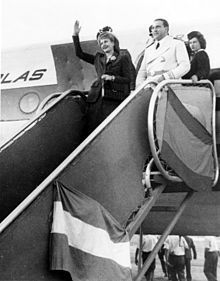
In 1947, Eva embarked on a much-publicized "Rainbow Tour" of Europe, meeting with numerous dignitaries and heads of state, such as Francisco Franco and Pope Pius XII. Biographers Fraser and Navarro write that the tour had its genesis in an invitation the Spanish leader had extended to Juan Perón. For political reasons it was decided that Evita, rather than Juan Perón, should make the visit. Fraser and Navarro write that Argentina had only recently emerged from its "wartime quarantine" thus taking its place in the United Nations and improving relations with the United States. Therefore, a visit to Franco, with Salazar the last remaining west European authoritarian leader in power, would be diplomatically frowned upon internationally. Fraser and Navarro write that Eva decided that if Juan Perón would not accept Franco's invitation for a state visit to Spain, then she would. Advisors then decided that Eva should visit many European countries in addition to Spain. This would make it seem that Eva's sympathies were not specifically with Franco's fascist Spain but with all of Europe. The tour was billed not as a political tour but as a non-political "goodwill" tour.
Eva was well received in Spain, where she visited Capilla Real, the tombs of Spanish monarchs Ferdinand and Isabella. Francoist Spain had not recovered from the Spanish Civil War (the autarkic economy and the UN embargo meant that the country could not feed its people). During her visit to Spain, Eva handed out 100- peseta notes to many poor children she met on her journey. She also received from Franco the highest award given by the Spanish government, the Order of Isabella the Catholic.
Eva then visited Rome, where the reception was not as warm as it had been in Spain. Though Pope Pius XII did not give her a Papal decoration, she was allowed the time usually allotted queens and was given a rosary.
Her next stop was France, where she was generally well received. She visited the Palace of Versailles, among other sites. She also met with Charles de Gaulle. She promised France two shipments of wheat.
While in France, Eva received word that George VI would not receive her when she planned to visit Britain, regardless of what his Foreign Office might advise, and that her visit would not be viewed as a state visit. Fraser and Navarro wrote that Eva regarded the royal family's refusal to meet her as a snub, and canceled the trip to the United Kingdom. Eva, however, gave "exhaustion" as the official reason for not going on to Britain.
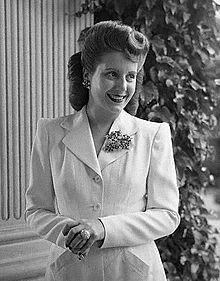
Eva also visited Switzerland during her European tour, a visit that has been viewed as the worst part of the trip. According to the book Evita: A Biography by John Barnes, while she traveled down a street with many people crowding her car, someone threw two stones and smashed the windshield. She threw her hands up in shock, but was not injured. Later, while sitting with the Foreign Minister, protesters threw tomatoes at her. The tomatoes hit the Foreign Minister and splattered on Eva's dress. After these two events, Eva had had enough, and after two months, returned to Argentina.
Members of the Peronist opposition speculated that the true purpose of the European tour was to deposit funds in a Swiss bank account. "The opposition in Buenos Aires," write Fraser and Navarro, "assumed that the genuine purpose of the whole European visit was for Eva and her brother to deposit money in Swiss bank accounts, and that the rest had been devised to conceal this. Many wealthy Argentines did this, but there are many more convenient and less conspicuous ways of depositing money in Swiss accounts than meeting the Swiss Foreign Minister and being shown around a watch factory." Fraser and Navarro conclude, "Was there a Swiss bank account? It seems unlikely."
During her tour to Europe, Eva Perón was featured in a cover story for Time magazine. The cover's caption–"Eva Perón: Between two worlds, an Argentine rainbow"–was a reference to the name given to Eva's European tour, The Rainbow Tour. This was the only time in the periodical's history that a South American first lady appeared alone on its cover (in 1951, Eva appeared again with Juan Perón). However, the 1947 cover story was also the first publication to mention that Eva had been born out of wedlock. In retaliation, the periodical was banned from Argentina for several months.
After returning to Argentina from Europe, Evita never again appeared in public with the complicated hairdos of her movie star days. The brilliant gold colour became more subdued in tone, and even the style changed, her hair being pulled back severely into a heavy braided chignon. Additionally, her extravagant clothing became more refined after the tour. No longer did she wear the elaborate hats and form-fitting dresses of Argentine designers. Soon she adopted simpler and more fashionable Paris couture and became particularly attached to the fashions of Christian Dior and the jewels of Cartier. In an attempt to cultivate a more serious political persona, Eva began to appear in public wearing conservative though stylish tailleurs (a business-like combination of skirts and jackets), which also were made by Dior and other Paris couture houses.
Charitable and feminist works
Eva Perón Foundation
The Sociedad de Beneficencia (Society of Beneficence), a charity group made up of 87 society ladies, was responsible for most charity works in Buenos Aires prior to the election of Juan Perón. Fraser and Navarro write that at one point the Sociedad had been an enlightened institution, caring for orphans and homeless women, but that those days had long since passed by the time of the first term of Juan Perón. In the 1800s, the Sociedad had been supported by private contributions, largely those of the husbands of the society ladies. But by the 1940s, the Sociedad was supported by the government.
It had been the tradition of the Sociedad to elect the First Lady of Argentina as president of the charity. But the ladies of the Sociedad did not approve of Eva Perón's impoverished background, lack of formal education, and former career as an actress. Fraser and Navarro write that the ladies of the Sociedad were afraid that Evita would set a bad example for the orphans, therefore the society ladies did not extend to Evita the position of president of their organization. It has often been said that Evita had the government funding for the Sociedad cut off in retaliation. Fraser and Navarro suggest that this version of events is in dispute, but that the government funding that had previously supported the Sociedad now went to support Evita's own foundation. The Fundación María Eva Duarte de Perón was created on 8 July 1948. It was later renamed to, simply, the Eva Perón Foundation. Its funding began with 10,000 pesos provided by Evita herself.
In The Woman with the Whip, the first English language biography of Eva Perón, author Mary Main writes that no account records were kept for the foundation because it was merely a means of funneling government money into private Swiss bank accounts controlled by the Peróns. Fraser and Navarro, however, counter these claims, writing that Ramón Cereijo, Minister of Finance, kept records, and that the foundation "began as the simplest response to the poverty (Evita) encountered each day in her office" and "the appalling backwardness of social services—or charity, as it was still called—in Argentina." Crassweller writes that the foundation was supported by donations of cash and goods from the Peronist unions, private businesses, and that the Confederación General del Trabajo donated three man-days (later reduced to two) of salary for every worker per year. Tax on lottery and movie tickets also helped to support the foundation, as did a levy on casino and revenue from horse races. Crassweller also notes that there were some cases of businesses being pressured to donate to the foundation, with negative repercussions resulting if requests for donations were not met.
Within a few years, the foundation had assets in cash and goods in excess of three billion pesos, or over $200 million at the exchange rate of the late 1940s. It employed 14,000 workers, of whom 6,000 were construction workers, and 26 priests. It purchased and distributed annually 400,000 pairs of shoes, 500,000 sewing machines, 200,000 cooking pots. The foundation also gave scholarships, built homes, hospitals, and other charitable institutions. Every aspect of the foundation was under Evita's supervision. The foundation also built entire communities, such as Evita City, which still exists today. Fraser and Navarro claim that due to the works and health services of the foundation, for the first time in history there was no inequality in Argentine health care.
Fraser and Navarro write that it was Evita's work with the foundation that played a large role in her idealization, even leading some to consider her a saint. Though it was unnecessary from a practical standpoint, Evita set aside many hours per day to meet with the poor who requested help from her foundation. During these meetings with the poor, Evita often kissed the poor and allowed them to kiss her. Evita was even witnessed placing her hands in the suppurated wounds of the sick and poor, touching the leprous, and kissing the syphilitic. Fraser and Navarro write that though Argentina is secular in many respects, it is essentially a Catholic country. Therefore, when Evita kissed the syphilitic and touched the leprous she "...ceased to be the President's wife and acquired some of the characteristics of saints depicted in Catholicism." Poet José María Castiñeira de Dios, a man from a wealthy background, reflected on the times he witnessed Evita meeting with the poor: "I had had a sort of literary perception of the people and the poor and she had given me a Christian one, thus allowing me to become a Christian in the profoundest sense...."
Fraser and Navarro write that toward the end of her life, Evita was working as many as 20 to 22 hours per day in her foundation, often ignoring her husband's request that she cut back on her workload and take the weekends off. The more she worked with the poor in her foundation, the more she adopted an outraged attitude toward the existence of poverty, saying, "Sometimes I have wished my insults were slaps or lashes. I've wanted to hit people in the face to make them see, if only for a day, what I see each day I help the people." Crassweller writes that Evita became fanatical about her work in the foundation and felt on a crusade against the very concept and existence of poverty and social ills. "It is not surprising," writes Crassweller, "that as her public crusades and her private adorations took on a narrowing intensity after 1946, they simultaneously veered toward the transcendental." Crassweller compares Evita to Ignatius Loyola, saying she came to be akin to a one-woman Jesuit Order.
Female Peronist Party and women's suffrage
Biographers Fraser and Navarro wrote that Eva Perón has often been credited with gaining the right to vote for Argentine women. While Eva did make radio addresses in support of women's suffrage and also published articles in her Democracia newspaper asking male Peronists to support women's right to vote, ultimately the ability to grant to women the right to vote was beyond Eva's powers. Fraser and Navarro claim that Eva's actions were limited to supporting a bill introduced by one of her supporters, Eduardo Colom, a bill that was eventually dropped.
A new women's suffrage bill was introduced, which the Senate of Argentina sanctioned on 21 August 1946. It was necessary to wait more than a year before the House of Representatives sanctioned it on 9 September 1947. Law 13,010 established the equality of political rights between men and women and universal suffrage in Argentina. Finally, Law 13,010 was approved unanimously. In a public celebration and ceremony, however, Juan Perón signed the law granting women the right to vote, and then he handed the bill to Eva, symbolically making it hers.
Eva Perón then created the Female Peronist Party, the first large female political party in the nation. Navarro and Fraser write that by 1951, the party had 500,000 members and 3,600 headquarters across the country. Navarro and Fraser write that while Eva Perón did not consider herself a feminist, her impact on the political life of women was decisive. Thousands of previously apolitical women entered politics because of Eva Perón. They were the first women active in Argentine politics. The combination of female suffrage and the organization of the Female Peronist Party granted Juan Perón a large majority (sixty-three percent) of the vote in the 1951 presidential elections.
1951 Presidential election
Vice Presidential nomination
In 1951, Evita set her sights on earning a place on the ballot as candidate for vice-president. This move angered many military leaders who despised Evita and her increasing powers within the government. According to the Argentine Constitution, the Vice President automatically succeeds the President in the event of the President's death. The possibility of Evita becoming president in the event of Juan Perón's death was not something the military could accept.
She did, however, receive great support from the working class, the unions, and the Peronist Women's Party. The intensity of the support she drew from these groups is said to have surprised even Juan Perón himself. Fraser and Navarro write that the wide support Evita's proposed candidacy generated indicated to him that Evita had become as important to members of the Peronist party as Juan Perón himself was.
On 22 August 1951, the unions held a mass rally of two million people called "Cabildo Abierto." (The name "Cabildo Abierto" was a reference and tribute to the first local Argentine government of the May Revolution, in 1810.) The Peróns addressed the crowd from the balcony of a huge scaffolding set up on the Avenida 9 de Julio, several blocks away from the Casa Rosada, the official government house of Argentina. Overhead were two large portraits of Eva and Juan Perón. It has been claimed that "Cabildo Abierto" was the largest public display of support in history for a female political figure.
At the mass rally, the crowd demanded that Evita publicly announce her candidacy as vice president. She pleaded for more time to make her decision. The exchange between Evita and the crowd of two million became, for a time, a genuine and spontaneous dialogue, with the crowd chanting, "¡Evita, Vice-Presidente!" When Evita asked for more time so she could make up her mind, the crowd demanded, "¡Ahora, Evita, ahora!" ("Now, Evita, now!"). Eventually, they came to a compromise. Evita told the audience that she would announce her decision over the radio a few days later.
Declining health
Eventually, she declined the invitation to run for vice-president, saying that her only ambition was that—in the large chapter of history that would be written about her husband—the footnotes would mention a woman who brought the "...hopes and dreams of the people to the president," a woman who eventually turned those hopes and dreams into "glorious reality." In Peronist rhetoric, this event has come to be referred to as "The Renouncement," portraying Evita as having been a selfless woman in line with the Hispanic myth of marianismo. Most biographers, however, postulate that Evita did not so much renounce her ambition, as bow to pressure from her husband, the military, and the Argentine upper class, who preferred that she not enter the race.
On January 9, 1950, Evita fainted in public and underwent surgery three days later. Although it was reported that she had undergone an appendectomy, she had actually developed advanced cervical cancer. Fainting continued through 1951 (including the evening after "Cabildo abierto"), with extreme weakness and severe vaginal bleeding. By 1951, it had also become evident that her health was rapidly deteriorating. Although her diagnosis was withheld from her by Juan, she knew she was not well, and a bid for the vice-presidency was not practical in light of her condition. Only a few months after "the Renouncement," Evita underwent a secret radical hysterectomy in an attempt to eradicate her advanced cervical cancer. In 2011, a Yale neurosurgeon studied Evita's skull x-rays and photographic evidence and stated that Perón was possibly given a prefrontal lobotomy in the last months of her life, "...to relieve the pain, agitation and anxiety she suffered in the final months of her illness."
Re-election and Spiritual Leader of the Nation
On 4 June 1952, Evita rode with Juan Perón in a parade through Buenos Aires in celebration of his re-election as President of Argentina. Evita was by this point so ill that she was unable to stand without support. Underneath her oversized fur coat was a frame made of plaster and wire that allowed her to stand. She took a triple dose of pain medication before the parade, and took another two doses when she returned home.
In a ceremony a few days after Juan Perón's second inauguration, Evita was given the official title of "Spiritual Leader of the Nation."
Death
Death and funeral
Despite having undergone a hysterectomy by the American surgeon George T. Pack, Evita's cervical cancer returned rapidly. She was the first Argentine to undergo chemotherapy (a novel treatment at that time). Despite all available treatment, she became emaciated, weighing only 36 kg (79 lb) by June 1952. Evita died at the age of 33, at 8:25 p.m., on 26 July 1952. The news was immediately broadcast throughout the country, and Argentina went into mourning. All activity in Argentina ceased; movies stopped playing; restaurants were closed and patrons were shown to the door. A radio broadcast interrupted the broadcasting schedule, with the announcer reading, "The Press Secretary's Office of the Presidency of the Nation fulfills its very sad duty to inform the people of the Republic that at 20:25 hours Mrs. Eva Perón, Spiritual Leader of the Nation, died." Eva Perón was granted a state funeral and a full Roman Catholic requiem mass. On the 9th of August, Saturday, the body was transferred to the Congress Building for an additional day of public viewing. On Sunday the 10th of August, after a final Sunday mass, the coffin was laid atop on a gun carriage pulled by CGT officials. Following was Peron, his cabinet, Eva's family and friends, the delegates and representatives of the Partido Peronista Femenino—then workers, nurses and students of the Eva Peron Foundation. Flowers were thrown from balconies and windows.
Mourning
On Eva Perón's death, the government suspended all official activities for two days and ordered all flags flown at half-staff for ten days. It soon became apparent, however, that these measures fell short of reflecting popular grief. The crowd outside of the presidential residence grew dense, congesting the streets for ten blocks in each direction. Later, while Evita's body was being moved, eight people were crushed to death in the throngs. In the following 24 hours, over 2000 people were treated in city hospitals for injuries sustained in the rush to be near Evita as her body was being transported from the presidential residence to the Ministry of Labour building.
The streets of Buenos Aires overflowed with huge piles of flowers stacked. Within a day of Evita's death, all flower shops in Buenos Aires had run out of stock. Despite the fact that Eva Perón never held a political office, she was eventually given an official funeral usually reserved for a head of state. A memorial was held for the Argentine team during the 1952 Summer Olympics in Helsinki due to Eva Perón's death during those games.
There were different interpretations of the popular mourning of Eva Perón's death. Some reporters viewed that the mourning was authentic, while others felt that the popular grief was merely the result of the public succumbing to the "passion plays" of the Peronist regime. For example, according to a Time magazine article published on 11 August 1952 entitled "In Mourning," the Peronist government enforced the beginning of daily periods of five minutes of mourning, following the daily radio announcement.
During Evita's time, children born to unmarried parents did not have the same legal rights as those born to married parents. Biographer Julie M. Taylor, professor of anthropology at Rice University, has said that Evita was well aware of the pain of being born "illegitimate." Taylor speculates that Evita's awareness of this may have influenced her decision to have the law changed so that "illegitimate" children would henceforth be referred to as "natural" children. Upon her death, the Argentine public was told that Evita was only 30. The discrepancy was meant to dovetail with Evita's earlier tampering with her birth certificate. After becoming the first lady in 1946, Evita had her birth records altered to read that she had been born to married parents, and placed her birth date three years forward, making herself younger.
Memorial plans
Shortly after Evita's death, Dr. Pedro Ara was approached to embalm the body. Fraser and Navarro write that it is doubtful that Evita herself ever expressed a wish to be embalmed, and suggest that it was most likely Juan Perón's decision. Dr. Ara was a professor of anatomy who had studied in Vienna and maintained an academic career in Madrid. His work was occasionally referred to as "the art of death." His highly advanced embalming technique consisted of replacing the corpse's blood with glycerine, which preserved all organs including the brain and created a very lifelike appearance, giving the body the appearance of "artistically rendered sleep." Dr. Ara was known in Buenos Aires society for his work. Among the people he had embalmed was Spanish composer Manuel de Falla. Dr. Ara claims that his embalming of Evita's corpse began on the night of her death and that by the next morning "the body of Eva Perón was completely and infinitely incorruptible" and therefore suitable for display to the public.
In the book Peron and the Enigmas of Argentina, biographer Robert D. Crassweller claims that the English-speaking nations of North America and Europe largely misunderstood Argentina's response to the death of Eva Perón as well as the ornate funeral she was granted. Crassweller attributes this misunderstanding to the unique cultural makeup of the Peróns and Argentina itself, claiming that the Peróns are of the Hispanic tradition and that their opposition was largely of British extraction:
-
- Almost lost among the memories of Evita that have caught the imagination of the world there was another that has been little noted but whose importance is considerable: the legacy of incomprehension. Her brief and dazzling years were so successful because, in good part, she was so profoundly of the ethos. 'I have the body and the soul and the blood of the people.' But it was the ethos of the old, Hispanic- Creole tradition, born in the interior out of Lima and nurtured on the Pampas. Like Perón, she was wholly indigenous in origin, formation, and spirit; like him, she was distrusted and misunderstood in the Argentina of the Liberal System and in the outside world that knew only that Argentina.
-
- The same was true with regard to Evita's dramatised death during her last ten months, the dying in public that she sought as confirmation of her devotion. Such an attitude toward mortality is a variation of the old Hispanic preoccupation with death and with the dignity and splendour associated with it. It had by then faded away in most of the European Catholic societies and it is unknown in the English-speaking nations. Therefore, many saw her ordeal and the response of Perón and of the vast public as elements in an essentially political passion play, an attempt to milk some sympathy and benefit out of what should have been a private tragedy. It was simply the legacy of incomprehension, the same legacy that made it impossible for Evita and Perón to grasp fully the emotional intensity of much of the world reaction to the seizure of La Prensa, or other repressions of the Peronato [meaning what?]. Thus Evita lived and died, an object of wonder to the world and a memorial to the inability of one ethos truly to understand another.
Disappearance and return of corpse
Shortly after Evita's death, plans were made to construct a memorial in her honour. The monument, which was to be a statue of a man representing the "descamisados," was projected to be larger than the Statue of Liberty. Evita's body was to be stored in the base of the monument and, in the tradition of Lenin's corpse, to be displayed for the public. While waiting for the monument to be constructed, Evita's embalmed body was displayed in her former office at the CGT building for almost two years. Before the monument to Evita was completed, Juan Perón was overthrown in a military coup, the Revolución Libertadora, in 1955. Perón hastily fled the country and did not make arrangements to secure Evita's body.
Following his flight, a military dictatorship took power in Argentina. The new authorities removed Evita's body from display and its whereabouts remained a mystery for 16 years. From 1955 until 1971, the military dictatorship of Argentina issued a ban on Peronism. It became illegal not only to possess pictures of Juan and Eva Perón in one's home, but even to speak their names. In 1971, the military revealed that the body was buried in a crypt in Milan, Italy, under the name "María Maggi." In 1995, Tomás Eloy Martínez published "Santa Evita," a work propounding many new stories about the escapades of the corpse—including allegations that many wax copies had been made, that the corpse had been damaged with a hammer, and that one of the wax copies was the object of an officer's sexual attentions.
Final resting place
In 1971, Evita's body was exhumed and flown to Spain, where Juan Perón maintained the corpse in his home. Juan and his third wife, Isabel, decided to keep the corpse in their dining room on a platform near the table. In 1973, Juan Perón came out of exile and returned to Argentina, where he became president for the third time. Perón died in office in 1974. His third wife, Isabel Perón, whom he had married on 15 November 1961, and who had been elected vice-president, succeeded him, thus becoming the first female president in the Western Hemisphere. It was Isabel who had Evita's body returned to Argentina and (briefly) displayed beside Juan Perón's. The body was later buried in the Duarte family tomb in La Recoleta Cemetery, Buenos Aires.
The Argentine government took elaborate measures to make Evita's tomb secure. The tomb's marble floor has a trapdoor that leads to a compartment that contains two coffins. Under that compartment is a second trapdoor and a second compartment. That is where Evita's coffin rests. Biographers Marysa Navarro and Nicholas Fraser write that the claim is often made that Evita's tomb is so secure that it could withstand a nuclear attack. "It reflects a fear," they write, "a fear that the body will disappear from the tomb and that the woman, or rather the myth of the woman, will reappear." This cemetery, which is located in the northern part of barrio Recoleta, also holds the remains of many illustrious military generals, presidents, scientists, poets and other affluent Argentinians.
Legacy and criticism
Argentina and Latin America
"In all of Latin America, only one other woman has aroused an emotion, devotion and faith comparable to those awakened by the Virgin of Guadalupe. In many homes, the image of Evita is on the wall next to the Virgin."
In his essay titled "Latin America" published in The Oxford Illustrated History of Christianity, John McManners also claims that the appeal and success of Eva Perón can be related in terms of Latin American mythology and concepts of divinity. McManners even claims that Eva Perón consciously incorporated aspects of the mythology of the Virgin and of Mary Magdalene into her public persona. Historian Hubert Herring has described Eva Perón as "Perhaps the shrewdest woman yet to appear in public life in Latin America."
In a 1996 interview, Tomás Eloy Martínez referred to Eva Perón as "the Cinderella of the tango and the Sleeping Beauty of Latin America." Martínez suggested Eva Perón has remained an important cultural icon for the same reasons as fellow Argentine Che Guevara:
"Latin American myths are more resistant than they seem to be. Not even the mass exodus of the Cuban raft people or the rapid decomposition and isolation of Fidel Castro's regime have eroded the triumphal myth of Che Guevara, which remains alive in the dreams of thousands of young people in Latin America, Africa and Europe. Che as well as Evita symbolize certain naive, but effective, beliefs: the hope for a better world; a life sacrificed on the altar of the disinherited, the humiliated, the poor of the earth. They are myths which somehow reproduce the image of Christ."
Though it is not a government holiday, the anniversary of Eva Perón's death is marked by Argentines every year. Additionally, Eva Perón has been featured on Argentine coins, and a form of Argentine currency called "Evitas" was named in her honour. Ciudad Evita (Evita City), which was established by the Eva Perón Foundation in 1947, is located just outside Buenos Aires. Cristina Kirchner, the first elected female president in Argentinian history, is a Peronist who has occasionally been referred to as "The New Evita." Kirchner says she does not want to compare herself to Evita, claiming Evita was a unique phenomenon in Argentine history. However, Kirchner says that women of her generation who came of age in the 1970s during the military dictatorships in Argentina owe a debt to Evita for offering an example of passion and combativeness. On 26 July 2002, the 50th anniversary of Eva Perón's death, a museum opened in her honour called "Museo Evita." The museum, created by her great-niece Cristina Alvarez Rodriquez, houses many of Eva Perón's clothes, portraits, and artistic renderings of her life, and has become a popular tourist attraction. The museum was opened in a building that was once used by the Eva Perón Foundation.
In the book Eva Perón: The Myths of a Woman, cultural anthropologist Julie M. Taylor claims that Evita has remained important in Argentina due to the combination of three unique factors:
"In the images examined, the three elements consistently linked— femininity, mystical or spirituality power, and revolutionary leadership—display an underlying common theme. Identification with any one of these elements puts a person or a group at the margins of established society and at the limits of institutional authority. Anyone who can identify with all three images lays an overwhelming and echoing claim to dominance through forces that recognize no control in society or its rules. Only a woman can embody all three elements of this power."
Taylor argues that the fourth factor in Evita's continued importance in Argentina relates to her status as a dead woman and the power that death holds over the public imagination. Further, Taylor claims that Evita's embalmed corpse is analogous to the incorruptibility of various Catholic saints, such as Bernadette Soubirous, and therefore holds powerful symbolism within the largely Catholic cultures of Latin America.
"To some extent her continuing importance and popularity may be attributed not only to her power as a woman but also to the power of the dead. However, a society's vision of the afterlife may be structured, death by its nature remains a mystery, and, until society formally allays the commotion it causes, a source of disturbance and disorder. Women and the dead— death and womanhood —stand in similar relation to structured social forms: outside public institutions, unlimited by official rules, and beyond formal categories. As a female corpse reiterating the symbolic themes of both woman and martyr, Eva Perón perhaps lays double claim to spiritual leadership."
In 2011, two giant murals of Evita on the building facades of the current Ministry of Social Development, located on 9 de Julio Avenue, were unveiled. The works were created by Argentine artist Alejandro Marmo. On July 26, 2012, to commemorate the sixtieth anniversary of Evita's death, there began to be issued publicly tickets with a value of 100 pesos, in which the controversial effigy of Julio Argentino Roca is replaced by that of Eva Duarte, making the first real woman that appears on the coins of Argentina. The image in the notes is based on the design of 1952, whose sketch was found in the Mint, made by the engraver Sergio Pilosio with artist Roger Pfund settings. The emission totals 20 million tickets and is not yet clear whether it will fully replace the notes with the images of Roca and the Desert Campaign.
Allegations of fascism
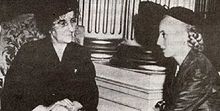
Biographers Nicholas Fraser and Marysa Navarro write that Juan Perón's opponents had from the start accused Perón of being a fascist. Spruille Braden, a diplomat from the United States who was greatly supported by Juan Perón's opponents, campaigned against Juan Perón's first candidacy on the platform that Juan Perón was a fascist and a Nazi. Fraser and Navarro also theorize that the perception of the Peróns as fascists was enhanced during Evita's 1947 European tour during which she was a guest of honour of Francisco Franco. By 1947, Franco had become politically isolated as one of the few remaining fascists to retain power. Franco, therefore, was in desperate need of a political ally. As much as a third of Argentina's population is of Spanish descent, and therefore it seemed natural that Argentina would have diplomatic relations with Spain. Commenting on the international perception of Evita during her 1947 European tour, Fraser and Navarro write, "It was inevitable that Evita be viewed in a fascist context. Therefore, both Evita and Perón were seen to represent an ideology which had run its course in Europe, only to re-emerge in an exotic, theatrical, even farcical form in a faraway country."
Laurence Levine, the former president of the U.S.-Argentine Chamber of Commerce, writes that in contrast to Nazi ideology, the Peróns were not anti-Semitic. In the book Inside Argentina from Perón to Menem: 1950–2000 from an American Point of View, Levine writes:
"The American government demonstrated no knowledge of Perón's deep admiration for Italy (and his distaste for Germany, whose culture he found too rigid). Nor did they appreciate that although anti-Semitism existed in Argentina, Perón's own views and his political associations were not anti-Semitic. They paid no attention to the fact that Perón sought out the Jewish community in Argentina to assist in developing his policies and that one of his most important allies in organizing the industrial sector was José Ber Gelbard, a Jewish immigrant from Poland."
Biographer Robert D. Crassweller writes, "Peronism was not fascism," and "Peronism was not Nazism." Crassweller also refers to the comments of U.S. Ambassador George S. Messersmith. While visiting Argentina in 1947, Messersmith made the following statement: "There is not as much social discrimination against Jews here as there is right in New York or in most places at home."
In his review of the 1996 movie Evita, movie critic Roger Ebert criticized Eva Perón, writing. "She let down the poor, shirtless ones by providing a glamorous facade for a fascist dictatorship, by salting away charity funds, and by distracting from her husband's tacit protection of Nazi war criminals." Time Magazine later published an article by Tomás Eloy Martínez—Argentine writer, journalist, and former director of the Latin American program at Rutgers University—titled "The Woman Behind the Fantasy: Prostitute, Fascist, Profligate—Eva Peron Was Much Maligned, Mostly Unfairly". In this article, Martínez writes that the accusations that Eva Perón was a fascist, a Nazi, and a thief have been leveled against Evita for decades. Martínez writes that these accusations are actually untrue:
"She was not a fascist—ignorant, perhaps, of what that ideology meant. And she was not greedy. Though she liked jewelry, furs and Dior dresses, she could own as many as she desired without the need to rob others…. In 1964 Jorge Luis Borges stated that 'the mother of that woman [Evita]' was 'the madam of a whorehouse in Junín.' He repeated the calumny so often that some still believe it or, more commonly, think Evita herself, whose lack of sex appeal is mentioned by all who knew her, apprenticed in that imaginary brothel. Around 1955 the pamphleteer Silvano Satander employed the same strategy to concoct letters in which Evita figures as an accomplice of the Nazis. It is true that (Juan) Perón facilitated the entrance of Nazi criminals to Argentina in 1947 and 1948, thereby hoping to acquire advanced technology developed by the Germans during the war. But Evita played no part. She was far from being a saint, despite the veneration of millions of Argentines, but she was not a villain either."
In his doctoral dissertation at Ohio State University, Lawrence D. Bell writes that the governments that preceded Juan Perón had been anti-Semitic but that Juan Perón's government was not. Juan Perón "eagerly and enthusiastically" attempted to recruit the Jewish community into his government and even set up an entire branch of the Peronist government for Jewish members. Juan Perón's government was the first to court the Argentine Jewish community and the first to allow Jewish citizens to hold public office. Kevin Passmore writes that the Peronist regime, more than any other Latin American regime, has been accused of being fascist. Passmore claims, however, that the Peronist regime was not fascist, and fascism under Perón never took hold in Latin America. Additionally, because the Peronist regime allowed for rival political parties to exist, the Peronist regime cannot be described as totalitarian.
International popular culture
By the late 20th century, Eva Perón had become the subject of numerous articles, books, stage plays, and musicals, ranging from the biography The Woman with the Whip to a 1981 TV movie called Evita Perón with Faye Dunaway in the title role. The most successful rendering of Eva Perón's life has been the musical production Evita. The musical began as a concept album co-produced by Tim Rice and Andrew Lloyd Webber, with Julie Covington in the title role. Elaine Paige was later cast in the title role when the concept album was adapted into a musical stage production in London's West End. In 1980, Patti LuPone won the Tony Award for Best Leading Actress in a Musical for her performance as the title character. Nicholas Fraser claims that to date "the musical stage production has been performed on every continent except Antarctica and has generated over $2 billion in revenue."
As early as 1978, the musical was considered as the basis for a movie. After a nearly 20-year production delay, Madonna was cast in the title role for the film version and won the Golden Globe Award for "Best Actress in a Musical or Comedy." In response to the American film, and in an alleged attempt to offer a more politically accurate depiction of Evita's life, an Argentine film company released Eva Perón: The True Story. The Argentine production starred actress Esther Goris in the title role. This movie was the 1996 Argentine submission for the Oscar in the category of "Best Foreign Language Film."
Nicholas Fraser writes that Evita is the perfect popular culture icon for our times because her career foreshadowed what, by the late 20th century, had become common. During Evita's time it was considered scandalous for a former entertainer to take part in public political life. Her detractors in Argentina had often accused Evita of turning public political life into show business. But by the late 20th century, Fraser claims, the public had become engrossed in the cult of celebrity and public political life had become insignificant. In this regard, Evita was perhaps ahead of her time. Fraser also writes that Evita's story is appealing to our celebrity-obsessed age because her story confirms one of Hollywood's oldest clichés, the rags to riches story. Reflecting on Eva Perón's popularity more than half a century after her death, Alma Guillermoprieto writes that, "Evita's life has evidently just begun."
